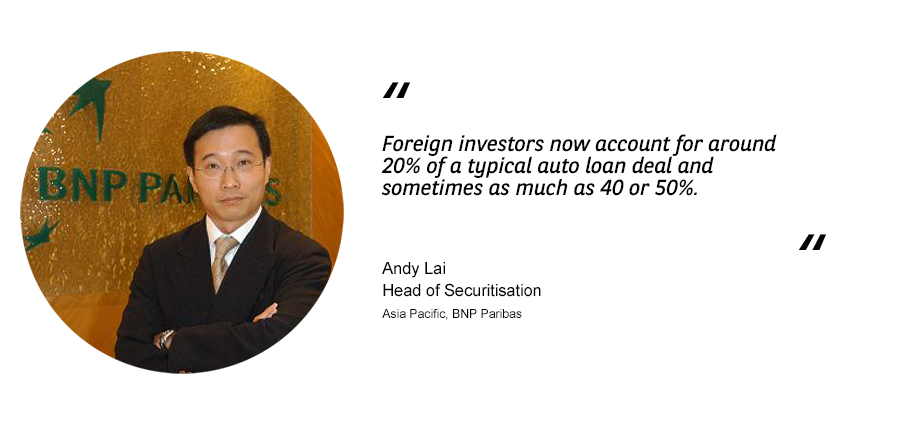China’s securitisation market has seen explosive growth since the launch of its asset-backed securitisation pilot scheme in 2005. In just 15 years, the market has grown to be the world’s second largest, with the backing and guidance of the People’s Bank of China (PBOC).
New issues of securitised bonds reached RMB 2.35 trillion ($331 billion) in 2019 and are expected to continue growing this year.
Securitisation: A brief explainer
Securitisation simply means taking a cash-generating asset and turning it into a marketable security (an Asset-Backed Security, or ABS) that investors can buy and sell. The assets in question are generally loans that guarantee future payments, or cash flows. Car loans, residential mortgages, credit card receivables and student loans are all types of assets that can be securitised.China’s ABS market has grown to become the world’s second largest.
Andy Lai, BNP Paribas
Banks and other non-bank financial institutions, such as car loan companies, package these loans together and sell them to investors. The investors are then entitled to the incoming cash flows.
Those with memories of 2008 may recall that securitisation – particularly of mortgage loans in the United States – played a significant role in the Global Financial Crisis.
“Securitisation in itself was not the problem. The problem in 2008 was more to do with the lack of discipline around ensuring debtors could actually make the payments on their loans,” explains Andy Lai, Head of Securitisation for Asia Pacific at BNP Paribas.
“Fortunately, markets have learnt their lessons and there is now a lot more discipline in the process of originating, or giving out loans to customers. That means the securitised asset is, in general, a much sounder investment proposition.”
| BMW steers the way in first auto loan ABS of 2020 Market conditions remain favourable, despite the Coronavirus pandemic. On the surface, it looked like a challenging time for a deal. BMW Automotive Finance (China), a subsidiary of the German carmaker that makes car loans to Chinese customers, was looking to sell RMB 8 billion ($1.1 billion) of Asset-Backed Notes – its largest ever issuance – to investors. For a start, it was right after the Lunar New Year holiday, a time when offices are deserted. China was also grappling with a new, highly infectious and potentially deadly coronavirus, Covid-19. Millions of people in central China were already under lockdown – a form of confinement that would soon become all too familiar to billions around the world. Yet when BNP Paribas helped take the deal to the market, investors flocked to secure their orders. In fact, there were twice as many orders as there were securities on offer. The success of the BMW deal, in challenging market conditions, is another fitting testament to China’s ABS success.  |
Accelerating through uncertain times
That discipline becomes especially important in times of global economic uncertainty. As the seriousness of the Covid-19 virus became apparent throughout February and March, global financial markets plunged into a nosedive. It would be natural to assume investors would look on new deals cautiously, preferring to hoard their cash for a rainy day.In the case of BMW, the opposite happened.
| BMW: A safe haven Such was the demand for the securities that the deal was priced with a yield that was around 0.35% lower than the yields when BMW last went to markets in China in November last year. A lower yield indicates greater demand among investors. The Munich-based company was able to beat the global trend of rising borrowing costs. “Investors told us that they saw the BMW deal as a safe haven, and they trusted and understood the stringent procedures around auto loans that are a feature of China’s ABS programme,” said Lai. Those stringent procedures have ensured that even as China’s economy contracted by 6.8% year-on-year in the first quarter of this year, delinquency rates on auto loans have remained low in relative terms. According to Moody’s, the delinquency rate for the Chinese auto loan asset-backed deals dropped to just 2.1% in March from 2.9% in February 2020. |
China: reforming, adapting
The Chinese government sees securitisation as an important source of alternate funding, as well as balance-sheet-management that can help in its battle to reign in shadow banking industry debts.There are four frameworks for securitisation in China, but the bulk of issuance is via the Credit Asset Securitisation scheme and the Corporate Asset Securitisation scheme. In 2019, 21.2% of all issuance was mortgage-backed, 8.4% was backed by auto loans and 3.6% by corporate loan receivables.
Most domestic securitisations in China’s RMB 103 trillion ($14.58 trillion) bond market are listed on the China Interbank Bond Market (CIBM), where the majority of investors are local financial institutions.
International investors are beginning to play a bigger part in the market, too, enabled by the Bond Connect scheme that allows Hong Kong-based investors direct access to the CIBM. “Bond Connect has helped by simplifying tax considerations,” says Lai. “Foreign investors now account for around 20% of a typical auto loan deal and sometimes as much as 40 or 50%.”

At the same time, the market offers a range of attractions to issuers like BMW.
“Securitisation makes a lot of sense for Chinese issuers,” says Lai. “They can diversify their sources of funding, achieve credit ratings for issuance that are higher than their corporate ratings, and lock in a cost of funding that is lower than what they would pay for conventional bonds.”
The way forward
Lai believes China’s ABS market will continue to mature and grow in scope and complexity, irrespective of the current uncertainty around Covid-19. He suggests that allowing issuers to issue in different currencies, and permitting the use of embedded currency and interest rate swaps in issuance structures, could enable the market to evolve further. “This would give issuers more options and help broaden the investor base for Chinese ABS,” he says.There is no doubt China’s regulatory body will be mulling those suggestions, and many others, in the years to come. For now though, it is a mostly happy anniversary for China’s securitisation pilot scheme – at a time when markets certainly need something to celebrate.
